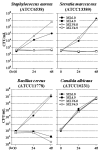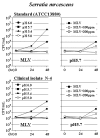Growth of microorganisms in total parenteral nutrition solutions containing lipid
- PMID: 20567610
- PMCID: PMC2880838
- DOI: 10.7150/ijms.7.101
Growth of microorganisms in total parenteral nutrition solutions containing lipid
Abstract
Background: To identify the microorganisms that can grow rapidly in total parenteral nutrition (TPN) solutions, we investigated the growth of the major causes of catheter-related blood stream infection (Staphylococcus aureus, Serratia marcescens, Bacillus cereus, and Candida albicans) in TPN solutions containing lipid.
Methods: The pH value of a TPN solution containing lipid (pH 6.0, containing 20 ppm of NaHSO(3)) was adjusted by the addition of HCl to 5.7, 5.4, or 4.9. The pH value of another TPN solution (pH5.5, containing 400 ppm of NaHSO(3)) was adjusted by the addition of NaOH to 5.9, 6.3, or 6.8. A specific number of each microorganism was added to 10 mL of each test solution and incubated at room temperature. The number of microorganisms was counted as colony forming units at 0, 24, and 48 hrs later.
Results: C albicans increased similarly at any pH values in the TPN solution. The bacterial species also increased rapidly at pH6.0 in the solution containing 20 ppm of NaHSO(3), but growth was suppressed as the pH value was reduced, with growth halted at pH4.9. However, these bacterial species did not increase, even at pH5.9, in the other solution containing 400 ppm of NaHSO(3).
Conclusions: These results suggest that Candida species can grow rapidly in almost all TPN solutions regardless of the acidity, lipid, and NaHSO(3); also, some bacterial species may grow in TPN solutions containing lipid unless the pH value is 5.0 or less. Therefore, each TPN solution should be examined whether or not the bacterial species can proliferate.
Keywords: CRBSI; TPN solution; bisulfite; lipid; microbial growth; pH.
Conflict of interest statement
Conflict of Interest: We declare that there are no conflicts of interest for all of us.
Figures











Similar articles
-
Growth of microorganisms in total parenteral nutrition solutions without lipid.Int J Med Sci. 2010 Jan 22;7(1):43-7. doi: 10.7150/ijms.7.43. Int J Med Sci. 2010. PMID: 20107529 Free PMC article.
-
Effects of lipid emulsion and multivitamins on the growth of microorganisms in peripheral parenteral nutrition solutions.Int J Med Sci. 2013 Jun 26;10(9):1079-84. doi: 10.7150/ijms.6407. Print 2013. Int J Med Sci. 2013. PMID: 23869182 Free PMC article.
-
Bactericidal and Antiproliferative Effects of Peripheral Parenteral Nutrition Solutions with Sodium Bisulfite on Pathogenic Microorganisms in Catheter Lumens.Int J Med Sci. 2020 Jul 11;17(12):1833-1839. doi: 10.7150/ijms.48829. eCollection 2020. Int J Med Sci. 2020. PMID: 32714086 Free PMC article.
-
Growth of bacteria and fungi in parenteral nutrition solutions containing albumin.Am J Hosp Pharm. 1981 Dec;38(12):1907-10. Am J Hosp Pharm. 1981. PMID: 6798862
-
Nutritional management of infants with short bowel syndrome.Semin Perinatol. 2007 Apr;31(2):104-11. doi: 10.1053/j.semperi.2007.02.009. Semin Perinatol. 2007. PMID: 17462495 Review.
Cited by
-
Risk Factors for Invasive Candida Infection in Critically Ill Patients: A Systematic Review and Meta-analysis.Chest. 2022 Feb;161(2):345-355. doi: 10.1016/j.chest.2021.08.081. Epub 2021 Oct 18. Chest. 2022. PMID: 34673022 Free PMC article.
-
Establishment and Validation of a Machine-Learning Prediction Nomogram Based on Lymphocyte Subtyping for Intra-Abdominal Candidiasis in Septic Patients.Clin Transl Sci. 2025 Jan;18(1):e70140. doi: 10.1111/cts.70140. Clin Transl Sci. 2025. PMID: 39835620 Free PMC article.
-
Risk of parenteral nutrition in neonates--an overview.Nutrients. 2012 Oct 16;4(10):1490-503. doi: 10.3390/nu4101490. Nutrients. 2012. PMID: 23201767 Free PMC article. Review.
-
Disparate Candida albicans Biofilm Formation in Clinical Lipid Emulsions Due to Capric Acid-Mediated Inhibition.Antimicrob Agents Chemother. 2019 Oct 22;63(11):e01394-19. doi: 10.1128/AAC.01394-19. Print 2019 Nov. Antimicrob Agents Chemother. 2019. PMID: 31405860 Free PMC article.
-
A scoring system based on novel biomarkers and clinical risk factors to predict invasive candidiasis in immunocompetent critically ill patients.Front Microbiol. 2023 Mar 9;14:1097574. doi: 10.3389/fmicb.2023.1097574. eCollection 2023. Front Microbiol. 2023. PMID: 36970699 Free PMC article.
References
-
- Banton J. Techniques to prevent central venous catheter infection: products, research, and recommendations. Nutr Clin Pract. 2006;21:56–61. - PubMed
-
- Mermel LA, Farr BM, Sherertz RJ. et al.Guidelines for the management of intravascular catheter-related infection. Clin Infect Dis. 2001;32:1249–1272. - PubMed
-
- Llop J, Badia MB, Comas D, Tubau M, Jodar R. Colonization and bacteremia risk factors in parenteral nutrition catheterization. Clin Nutr. 2001;20:527–534. - PubMed
-
- Allwood MC. Microbiological risks in parenteral nutrition compounding. Nutrition. 1997;13:60–61. - PubMed
-
- Didier ME, Fischer S, Maki DG. Total nutrient admixtures appear safer than lipid emulsion alone as regards microbial contamination: growth properties of microbial pathogens at room temperature. J Parenter Enteral Nutr. 1998;22:291–296. - PubMed
MeSH terms
Substances
LinkOut - more resources
Full Text Sources
Other Literature Sources
Research Materials

